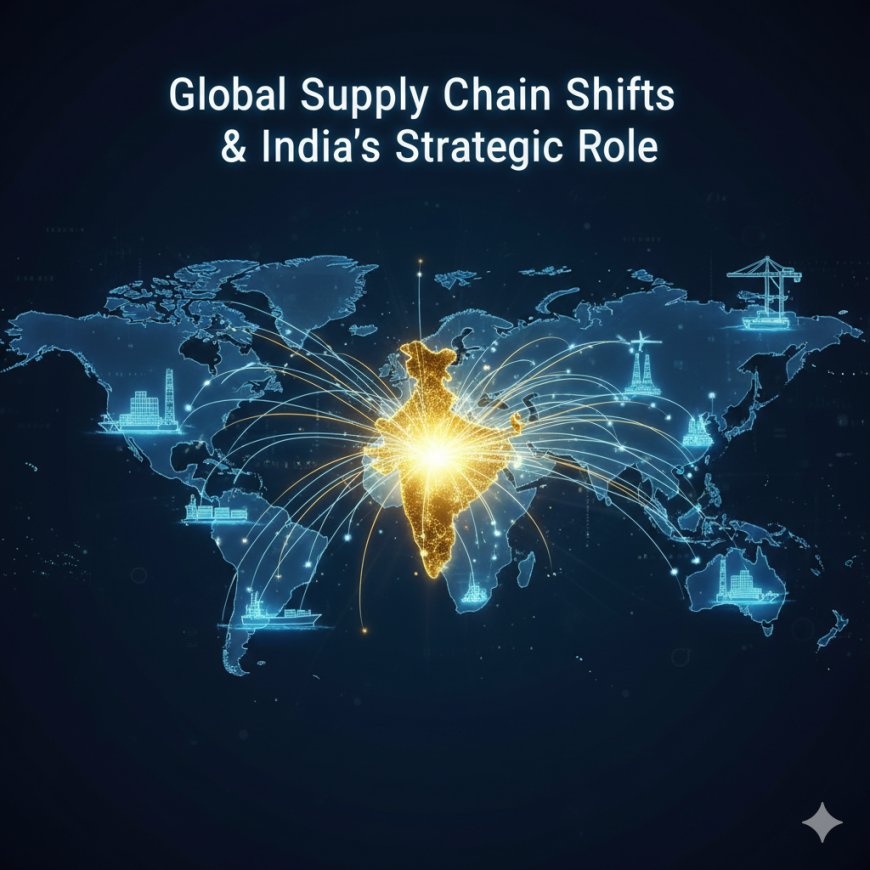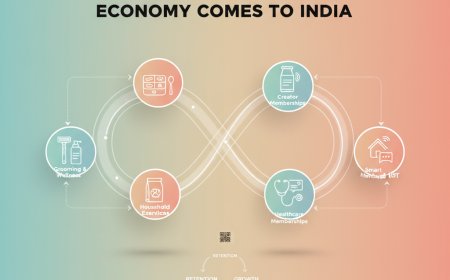Global Supply Chain Shifts & India’s Strategic Role
India is emerging as a key player in the global supply chain reset. Learn how infrastructure, policy reforms, and digital innovation are positioning India to become a global logistics and manufacturing powerhouse.

At the busy Jawaharlal Nehru Port near Mumbai, cranes move rhythmically as ships unload containers stacked with electronics, machinery, and textiles. Hundreds of miles away, in Tamil Nadu’s industrial corridor, factories hum with production — from auto parts to smartphones — as workers and robots share the floor. It’s a scene that captures a new global reality: the world’s supply chains are being rewritten, and India is emerging as a central player in this story.
The COVID-19 pandemic was the first major shock to the global trade system in decades. Empty shelves, shipping delays, and factory shutdowns made one thing clear — the “just-in-time” model that once powered global manufacturing was fragile. Then came geopolitical tensions — the U.S.-China trade war, the Russia-Ukraine conflict, and rising energy costs — further straining a system that had long prioritized cost efficiency over resilience.
Today, that old model is being replaced by a new mantra: “just-in-case.” Businesses are now asking, what happens if one link in the chain breaks? They’re looking for backup manufacturing bases, diversified suppliers, and more transparent logistics systems.
This shift has opened a historic opportunity for India. With its vast labor force, growing infrastructure, and reform-driven policies, India is being viewed not just as an alternative to China — but as a key strategic hub in the global supply chain network.
The question now is: what’s driving this momentum, and how can India turn it into long-term global leadership? That’s the journey we’ll explore next.
The Global Supply Chain Reset
Over the past few years, the global supply chain has gone through what can only be described as a massive reset.
When the pandemic struck, factories in one part of the world closed — and the ripple effects reached every corner. From automakers in Germany waiting for semiconductors to retailers in the U.S. struggling for stock, companies suddenly realized how dependent they were on single-country manufacturing hubs, especially China.
Then came more shocks:
- The Russia-Ukraine conflict disrupted global energy and food supply routes.
- U.S.-China trade tensions pushed multinational corporations to rethink where and how they source and assemble goods.
- Climate-related events — from floods to heatwaves — added a layer of unpredictability to global production cycles.
As a result, boardrooms worldwide began discussing two new buzzwords: “China+1” and “friendshoring.”
- China+1 means companies still keep operations in China but add another country — like India, Vietnam, or Mexico — to reduce risk.
- Friendshoring goes a step further, focusing on relocating production to politically and economically allied nations for stability and shared values.
This isn’t just theory anymore. According to reports by Deloitte and McKinsey, global firms plan to move up to 25% of their manufacturing outside China by 2030. That’s a massive realignment — and a potential trillion-dollar opportunity for emerging economies.
But this transformation isn’t only about moving factories. It’s also about building smarter, more resilient, and technology-driven supply chains.
Automation, artificial intelligence, and digital tracking tools are helping companies manage risk in real time, ensuring better visibility across borders and vendors. Sustainability, too, is becoming a key factor — with businesses looking to cut emissions and use renewable energy in logistics and production.
In this new world of supply chains, resilience is the new efficiency.
And as companies redraw their maps, India finds itself right at the intersection of opportunity and strategy — ready to connect global trade routes with local innovation.
Why India Stands Out
So, why is India suddenly on everyone’s radar when it comes to global supply chains? The answer lies in a powerful mix of people, policy, and potential.
First, there’s India’s biggest advantage — its large and skilled workforce. With over 500 million working-age people and a growing pool of engineers, technicians, and digital professionals, India offers the human capital that many nations are struggling to match. From assembly lines to advanced manufacturing and logistics, India’s workforce is increasingly both capable and cost-competitive.
Next comes the government’s reform push. Policies like the Production Linked Incentive (PLI) schemes are game-changers — encouraging global manufacturers to produce in India by offering financial rewards tied to output and exports. This has already drawn in big names across sectors like electronics, auto, and semiconductors.
Add to that a robust digital backbone. India’s rapid progress in digital infrastructure — from UPI payments and GST systems to e-logistics platforms — has made it easier to move goods, manage inventories, and track shipments in real time. Combine that with major investments in highways, ports, and freight corridors, and the logistics ecosystem is evolving fast.
Then there’s the domestic market advantage. India’s rising middle class, urban growth, and stable policy environment make it not just a place to manufacture — but also a huge consumer base for global brands. In other words, India offers both the factory and the market.
And we’re already seeing it happen. Apple and Foxconn are prime examples. After years of producing mainly in China, they’ve ramped up iPhone manufacturing in Tamil Nadu and Karnataka, exporting billions of dollars’ worth of devices. This shift isn’t just symbolic — it signals global confidence in India’s ability to deliver quality, scale, and reliability.
Sectors leading this transformation include electronics, semiconductors, automobiles, textiles, and pharmaceuticals. These industries are becoming the backbone of a more diversified and resilient Indian economy — one that’s deeply connected to global supply chains.
Put simply: India is no longer just an “option” in the global supply playbook — it’s becoming a strategic pillar.
The New Supply Chain Ecosystem: India’s Strategic Moves
India isn’t just waiting for global companies to arrive — it’s actively building the foundation for a world-class supply chain ecosystem.
A big part of this effort is policy-driven modernization. The National Logistics Policy (NLP) aims to make logistics faster, cheaper, and more efficient by cutting transport costs (currently around 13% of GDP) to global standards. Complementing it is the PM Gati Shakti Mission, which integrates infrastructure planning across railways, roads, ports, and airports — ensuring smoother, multimodal connectivity.
On the ground, this is taking shape through industrial corridors and smart cities.
The Chennai–Bengaluru Industrial Corridor connects two powerhouse states with ports, highways, and manufacturing zones. Meanwhile, Dholera Special Investment Region (SIR) in Gujarat is emerging as a high-tech industrial hub, attracting global firms in electronics and green energy.
India’s port modernization projects — from Mundra to Vizhinjam — are also enhancing its maritime trade capacity, while dedicated freight corridors are speeding up the movement of goods across the country. Together, these are transforming India into a seamless logistics network — something global manufacturers value deeply.
But what’s even more interesting is India’s focus on inclusive growth within this transformation. The government and industry bodies are working to integrate MSMEs and startups into global value chains, providing access to digital platforms, financing, and export markets. This approach ensures that small manufacturers and innovators can plug into the larger ecosystem — creating resilience from the bottom up.
Sustainability is also entering the picture. Green logistics, renewable-powered factories, and electric freight mobility are becoming priorities as India aligns its supply chain growth with its climate commitments.
In short, India isn’t just becoming a stop on the global supply route — it’s designing a new kind of ecosystem that’s digital, resilient, sustainable, and inclusive.
The Roadblocks Ahead
Of course, every big opportunity comes with its own set of hurdles — and India’s supply chain story is no different.
While the momentum is strong, several roadblocks still need attention before India can truly cement its place as a global supply chain powerhouse.
First, there are infrastructure and regulatory bottlenecks. Despite massive improvements in highways, ports, and industrial corridors, logistics costs in India remain higher than in many competing nations. Inconsistent regulations between states, slow land acquisition, and delayed approvals can still slow down large-scale projects — especially in sectors like electronics and semiconductors where speed matters.
Then there’s the financing gap. Many small and medium enterprises (MSMEs), which form the backbone of India’s manufacturing supply chain, struggle to access affordable credit. Without strong supply chain financing, smaller players find it hard to scale up or integrate with global partners.
Another crucial area is skills. Advanced manufacturing, digital tracking, and automation require a skilled workforce — and India needs to double down on upskilling programs to prepare workers for the future of logistics and smart factories. Initiatives like Skill India are a great start, but scaling them up is key to staying globally competitive.
And of course, competition isn’t standing still. Countries like Vietnam, Indonesia, and Mexico have also become attractive “China+1” destinations thanks to leaner regulations, trade agreements, and export-focused policies. To stand out, India must not only build capacity but also ensure speed and reliability — two things global manufacturers value most.
Ultimately, India’s success will depend on how fast and how collaboratively it can execute. A strong partnership between industry, government, and startups — where innovation meets policy and real-world solutions — will decide how far India can go in this new global race.
The good news? The foundation is already being built — what’s needed now is execution at scale.
The Future: India as a Global Supply Chain Powerhouse
Looking ahead, India’s role in global trade could go far beyond being a low-cost manufacturing destination. The vision is much bigger: to become a strategic value partner in innovation, logistics, and digital trade.
In this future, India won’t just assemble products — it will help design, digitize, and deliver them with smarter technology. And this transformation is already visible.
From AI-driven demand forecasting to blockchain-based traceability in exports, Indian logistics is undergoing a quiet revolution. Companies are adopting Internet of Things (IoT) sensors to monitor goods in real time, ensuring transparency from factory floor to final delivery. This not only improves efficiency but also builds trust — a crucial factor for global brands looking for reliable partners.
The country’s digital public infrastructure — from UPI to the ONDC (Open Network for Digital Commerce) — is also becoming a model for the world. These systems show how India can combine technology and policy innovation to create scalable, transparent ecosystems.
In parallel, sustainability will play a central role. India’s supply chain growth is increasingly being linked with green logistics, renewable-powered industrial clusters, and circular manufacturing models. The next phase of competitiveness will come from how sustainably a country can produce and move goods — and India has a head start with its renewable energy goals and green corridor initiatives.
The big picture? The global economy is realigning — and India has the chance to anchor the next era of resilient, inclusive, and sustainable supply chains.
The world is looking for a trusted partner that can balance scale, skill, and stability. If India continues on its current trajectory — combining bold policy reforms with digital innovation — it can become exactly that: a global supply chain powerhouse built for the 21st century.
Wrap-Up: Turning Momentum into Mastery
The global supply chain shift isn’t just an economic opportunity for India — it’s a test of readiness, resilience, and strategic foresight.
For decades, global trade revolved around efficiency and cost. But the world is now prioritizing resilience, trust, and technological agility — and this is exactly where India’s strengths are beginning to shine. The country’s growing infrastructure, digital ecosystem, and policy reforms have set the stage. What comes next is about execution and consistency.
The key takeaway?
If India continues to invest boldly in infrastructure, technology, and policy agility, it won’t just join the redefined global supply chain — it could help shape its future.
The world’s logistics map is being redrawn.
India’s challenge — and opportunity — is to ensure it’s not just on that map, but leading the route forward.
What's Your Reaction?
 Like
0
Like
0
 Dislike
0
Dislike
0
 Love
0
Love
0
 Funny
0
Funny
0
 Angry
0
Angry
0
 Sad
0
Sad
0
 Wow
0
Wow
0

























































































































































































